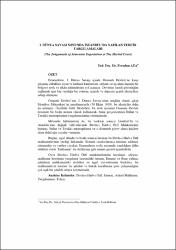I. Dünya Savaşı Sonunda İstanbul’da Yapılan Tehcir Yargılamaları
Özet
Ermenilerin, I. Dünya Savaşı içinde Osmanlı Devleti’ne karşı
girişmiş oldukları isyan ve katliam hareketleri, onların savaş alanı dışında bir
bölgeye sevk ve iskân edilmelerine yol açmıştır. Devletin, kendi güvenliğini
sağlamak için baş vurduğu bu yöntem, içeride ve dışarıda çeşitli eleştirilere
sebep olmuştur.
Osmanlı Devleti’nin, I. Dünya Savaşı’ndan mağlup olarak çıkıp
Mondros Mütarekesi’ni imzalamasıyla (30 Ekim 1918), bu eleştiriler daha
da artmıştır. Özellikle İtilâf Devletleri, bu sevk işlemini Osmanlı Devleti
üzerinde bir baskı unsuru olarak kullanarak, bunu gerçekleştiren İttihat ve
Terakki mensuplarının yargılanmalarını istemişlerdir.
Mütareke hükümetleri de, bu baskılar sonucu İstanbul’da ve
Anadolu’nun değişik vilâyetlerinde Divân-ı Harb-i Örfî Mahkemeleri
kurmuş, İttihat ve Terakki mensuplarına ve o dönemde görev almış kişilere
idam dahil ağır cezalar vermiştir.
Bugün, işgal altında ve baskı sonucu kurulan bu Divân-ı Harb-i Örfî
mahkemelerinin verdiği hükümler, Ermeni taraftarlarınca istismar edilmek
istenmekte ve verilen cezaları, Ermenilerin sevki sırasında yapıldığını iddia
ettikleri sözde “katliamın” bir deliliymiş gibi sunma gayreti içindedirler.
Oysa Divân-ı Harb-i Örfî mahkemelerinin kuruluşu, işleyişi,
mahkeme heyetinin yargılama sırasındaki tutumu, Ermeni ve Rum yalancı
şahitlerin mahkemedeki ifadeleri ve işgal kuvvetlerinin baskıları, bu
mahkemelerin tarafsız bir şekilde ve hukuk kurallarına göre çalışmadığını
çok açık bir şekilde ortaya koymaktadır. The Armenian attempts of massacre and rebellion against the
Ottoman Empire at the First World War caused Ottoman to send the
Armenian to anywhere out of battlefield and to get them to dwell there.
However, that method to which the Government referred for its security
resulted in lots of critiques both at home and abroad.
The number of critiques increased more and more when Ottoman
signed the Armistice of Mondros (30th October 1918) because of being
defeated at war. Especially, the Allies regarded sending of the Armenian as a
chance to put pressure on Ottoman and requested members of the Union and
Progress, who had sent the Armenian, to be tried.
Therefore the governments of armistice founded the Martial Court in
Istanbul and in the other Anatolian provinces, then condemned members of
the Union and Progress and others who were appointed in that period to
various grave punishments, including capital punishment.
Today, Armenian partisans want to abuse the sentences which were
passed by the Martial Court, founded under military occupation because of
the pressure, and they try to show punishments, given by trials of the Martial
Court, as an evidence of so-called Armenian massacre during sending
process.
Yet, the foundation of the Martial Court, its function, the attitude of
trial committe during judgement, testimonies of liar Greek and Armenian
witnesses and the pressures of the Allies clearly show the fact that these
trials of the Martial Court did not run impartially according to the judicial
laws.
Kaynak
Sosyal Bilimler DergisiCilt
7Sayı
1Bağlantı
http://hdl.handle.net/11630/3534Koleksiyonlar
- Cilt 7 : Sayı 1 [10]



















